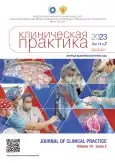Morphological and molecular genetic diagnosis of CADASIL: a rare clinical case
- Authors: Golubinskaya E.P.1, Makalish T.P.1, Kalfa M.A.1, Ostapenko O.V.1, Savchuk E.A.1, Zyablitskaya E.Y.1, Maksimova Р.E.1
-
Affiliations:
- V.I. Vernadsky Crimean Federal University
- Issue: Vol 14, No 2 (2023)
- Pages: 105-111
- Section: Case reports
- URL: https://journals.rcsi.science/clinpractice/article/view/142800
- DOI: https://doi.org/10.17816/clinpract121091
- ID: 142800
Cite item
Full Text
Abstract
Background: Cerebral autosomal dominant arteriopathy with subcortical infarcts and leukoencephalopathy (CADASIL) is a hereditary autosomal dominant vascular injury of the brain. Currently, the clinical diagnosis of CADASIL is based on the following criteria: the onset of the condition at a relatively young age (40–50 years), recurrent lacunar infarcts, gradual progression of encephalopathy with the development of pseudobulbar syndrome and dementia, various emotional disorders, and autosomal dominant inheritance. Having a family history of relatives with similar symptoms. The diagnosis is verified on the basis of the results of the following studies: neuroimaging, instrumental, morphological, and laboratory. The presence of leukoaraiosis and multiple small bilateral infarctions in such anatomical structures as the basal ganglia and white matter of the cerebral hemispheres, visual tubercles and the pons, and brain stem during MRI diagnostics. Histologically, transmission electron microscopy reveals granular osmiophilic inclusions in the adventitial membrane of the blood vessels of the brain, and on the periphery — in the adventitia of the vessels of skeletal muscles and somatic nerves and in vascular biopsies of skin flaps. A mutation in the Notch3 gene determines the clinic of the disease and morphological changes in blood vessels and is detected by a molecular genetic method. The article presents a clinical case, which was a manifestation of this rare hereditary microangiopathy.
Clinical case description: A 43-year-old patient was admitted to the Department of Neurology of the Republican Clinical Hospital in Simferopol for ischemic stroke in the basin of the left middle cerebral artery. According to the anamnesis, the patient suffered from migraine without aura from a young age and lacunar strokes; examination revealed a decrease in cognitive function, and MRI showed signs of microangiopathy of cerebral vessels. For final diagnosis, the patient underwent an intravital pathomorphological examination of the biopsy of the musculoskeletal flap; the results obtained made it possible to make a reliable diagnosis of CADASIL.
Conclusion: Understanding and knowledge of such a rare pathology as CADASIL is crucial for the rapid recognition of a characteristic clinical picture for further appointment and interpretation of the results of morphological and molecular genetic diagnostics, making it possible to make the correct diagnosis and treatment.
Keywords
Full Text
##article.viewOnOriginalSite##About the authors
Elena P. Golubinskaya
V.I. Vernadsky Crimean Federal University
Email: missive@mail.ru
ORCID iD: 0000-0003-3917-924X
SPIN-code: 8896-7481
Dr. Sci. (Med.)
Russian Federation, SimferopolTatyana P. Makalish
V.I. Vernadsky Crimean Federal University
Email: gemini_m@list.ru
ORCID iD: 0000-0003-1884-2620
SPIN-code: 1523-5893
PhD
Russian Federation, SimferopolMargarita A. Kalfa
V.I. Vernadsky Crimean Federal University
Email: rita.kalfa@mail.ru
ORCID iD: 0000-0002-7179-3402
SPIN-code: 2360-0775
MD, PhD
Russian Federation, SimferopolOlga V. Ostapenko
V.I. Vernadsky Crimean Federal University
Email: stepashca@mail.ru
ORCID iD: 0000-0002-2935-1985
SPIN-code: 5247-6359
MD, PhD, Associate Professor
Russian Federation, SimferopolElena A. Savchuk
V.I. Vernadsky Crimean Federal University
Email: Elena_Savchuk12@mail.ru
ORCID iD: 0000-0001-5261-5849
SPIN-code: 9631-8715
MD, PhD, Associate Professor
Russian Federation, SimferopolEvgenia Y. Zyablitskaya
V.I. Vernadsky Crimean Federal University
Email: evgu79@mail.ru
ORCID iD: 0000-0001-8216-4196
SPIN-code: 2267-3643
Dr. Sci. (Med.)
Russian Federation, SimferopolРolina E. Maksimova
V.I. Vernadsky Crimean Federal University
Author for correspondence.
Email: pmaksq@mail.ru
ORCID iD: 0000-0001-5920-8664
SPIN-code: 9734-8508
Dr. Sci. (Med.)
Russian Federation, SimferopolReferences
- Chabriat H, Bousser MG. Neuropsychiatric manifestations in CADASIL. Dialogues Clin Neurosci. 2007;9(2):199–208. doi: 10.31887/DCNS.2007.9.2/hchabriat
- Di Donato I, Bianchi S, de Stefano N, et al. Cerebral Autosomal Dominant Arteriopathy with Subcortical Infarcts and Leukoencephalopathy (CADASIL) as a model of small vessel disease: Update on clinical, diagnostic, and management aspects. BMC Med. 2017;15(1):41. doi: 10.1186/s12916-017-0778-8
- Иллариошкин С.Н., Сломинский П.А., Шадрина М.И., и др. Церебральная аутосомно-доминантная артериопатия с субкортикальными инфарктами и лейкоэнцефалопатией (ЦАДАСИЛ): первое описание российской семьи с идентифицированной мутацией в гене Notch3 // Анналы клинической и экспериментальной неврологии. 2008. Т. 2, № 2. С. 45–50. [Illarioshkin SN, Slominskij PA, Shadrinaidr MI. Cerebral autosomal dominant arteriopathy with subcortical infarcts and leukoencephalopathy (CADASIL): The first description of a Russian family with an identified mutation in the Notch3 gene. Annals of clinical and experimental neurology. 2008;2(2):45–50. (InRuss).]
- Gravesteijn G, Munting LP, Overzier M, et al. Progression and classification of Granular Osmiophilic Material (GOM) deposits in functionally characterized human NOTCH3 transgenic mice. Transl Stroke Res. 2020;11(3):517–527. doi: 10.1007/s12975-019-00742-7
- Felczak P, Cudna A, Błażejewska-Hyżorek B, et al. Ultrastructure of mitochondria and damage to small blood vessels in siblings with the same mutation in the NOTCH3 and coexisting diseases. Pol J Pathol. 2021;72(2):148–159. doi: 10.5114/pjp.2021.109517
- Gao D, Shang J, Sun R, et al. Changes in the morphology, number, and protein levels of plasma exosomes in CADASIL patients. J Alzheimers Dis. 2021;81(1):221–229. doi: 10.3233/JAD-210101
Supplementary files








